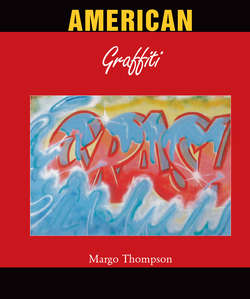Читать книгу American Graffiti - Margo Thompson - Страница 18
На сайте Литреса книга снята с продажи.
Subway Writers
FUTURA 2000
ОглавлениеFUTURA 2000 lived on the Upper West Side of Manhattan, near the 1 line, where he began tagging in 1971. Early on, he was aware of graffiti’s expressive potential and standards of quality. He admired PHASE 2 for his lettering style and aerosol technique. Another older writer, STAY HIGH 149 was famous for incorporating a stick figure appropriated from the logo for the television show The Saint and the sentiment he expressed with the caption ‘Voice of the Ghetto’.[84] The idea that graffiti spoke for a disenfranchised constituency resonated with FUTURA.
FUTURA’s early career ended in autumn 1973. While he and his friend ALI were painting in a tunnel there was an explosion, and ALI was severely burned.[85] FUTURA ceased writing on trains, and in 1974 he joined the Navy, serving until 1978. After his tour, he returned to New York where ALI, inviting reconciliation, contacted him to ask him to join Soul Artists, a group of graffiti writers who worked out of an abandoned laundromat on sign-painting commissions.[86] There FUTURA met ZEPHYR, a younger writer who had begun tagging trains in 1977, and by the end of 1979 they were writing on trains together.[87] In spring 1980, ZEPHYR invited him to run another graffiti studio, this one supported by businessman and art collector Sam Esses.[88] Where Soul Artists was a commercial enterprise, Graffiti 1980, also known as the Esses Studio, encouraged the production of writing as fine art: graffiti on canvas. The two months spent there, and an exhibition of graffiti art in October 1980 at Fashion Moda, an alternative gallery space in the South Bronx, led to FUTURA’s breakthrough design for a whole car piece where his tag was minimised.[89]
‘Break’, as the train was titled in the absence of a tag and to indicate its significance in his stylistic development, was an atmospheric, abstract arrangement of fields of colour. FUTURA said of his intentions, ‘I don’t need to see FUTURA here, now I want to see just color. I want to see a couple of design elements that people would put into their pieces, and see what does that hold for us. Is that interesting? And it was, it was almost a painting’.[90] On the left, white was broken with cool tones of blue, purple, and magenta, while magenta, green, and orange dominated the car from the windows to the centre doors. Just to the right of the doors, the cloud of colour was bounded by a black outline. Bright white around a field of purple broke through, and a second cloud of warm hues completely covered the rest of the train to the right. Scattered over the atmospheric field of colours were triangles and circles in white and black. ‘Break’, ‘Futura’ and ‘2000’ were written in thin black aerosol lines, so that the lettering was absolutely subordinate to the independent fields of colour. The clouds of brilliant hues inspired Richard Goldstein to credit the Russian expressionist painter Wassily Kandinsky as an influence, although FUTURA said he only saw Kandinsky’s paintings at a museum some time later.[91] The comparison stuck and was sometimes invoked when he exhibited abstract canvases in succeeding years.
DONDI, Children of the Grave Return, Part 2, 1980. Aerosol paint on New York subway car. Destroyed.
84
Hoekstra, ed., 134; Futura 2000, “Futura Speaks,” available from. Accessed 20 May 2006.
85
Hoekstra, ed., 134; Futura 2000, “Futura Speaks”; Michael T. Kaufman, “An Underground Graffitist Pleads from Hospital: Stop the Spraying,” New York Times, 18 October 1973, 49.
86
Interview with ZEPHYR, 4 November 2006.
87
Hoekstra, ed., 134.
88
Interview with ZEPHYR, 4 November 2006.
89
Miller, 192n2.
90
FUTURA quoted in Miller, 120.
91
Goldstein, “The Fire Down Below,” 55; Hoekstra, ed., 135. Carlo McCormick surmises that it was the Kandinsky retrospective at the Guggenheim in 1982 that FUTURA saw, and that he visited it with Kiely Jenkins, a downtown artist. (Interview with Carlo McCormick, 27 July 2006.)
